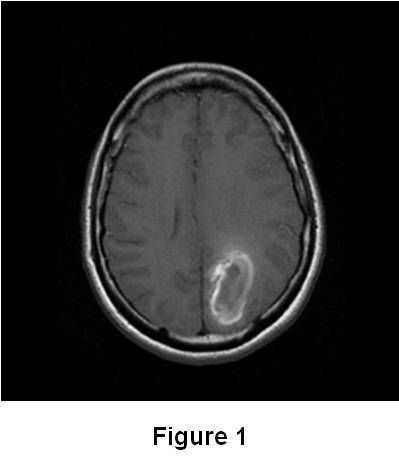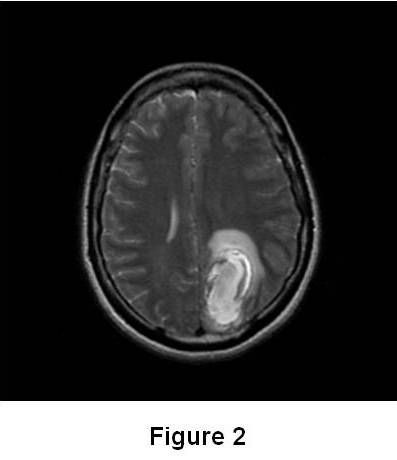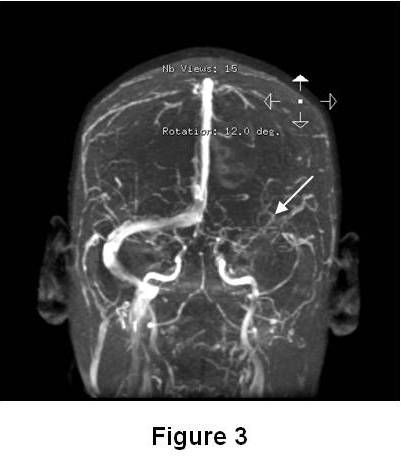- AI
- Molecular Imaging
- CT
- X-Ray
- Ultrasound
- MRI
- Facility Management
- Mammography
Dural Venous Thrombosis
A 32 year old African American female presents with temporal region headaches, including sudden onset of extreme pain with no exacerbating or relieving factors, as well as peripheral vision loss in the right eye. MRI, MRA, and MRV added diagnosis.
Clinical History
32 year old African American female presented with a complaint of headaches located in the temporal region. Pain described as sharp, rated 10/10, with sudden onset, and no exacerbating or relieving factors. She also complained of loss of peripheral vision in her right eye.
The onset of her headache began 8 days postpartum. She admitted to vertigo but no weakness, fever, neck stiffness or ataxia. She denied any change in intensity of headache with change in position. The remainder of her history was unremarkable.
Findings
Axial T1 weighted image of the brain demonstrated a ring-like region of signal hyperintensity within the left posterior parietal lobe (Figure 1).

Axial T2 weighted image demonstrated a corresponding large area of heterogeneously increased signal within the left posterior parietal lobe (Figure 2).

Magnetic Resonance Venogram (MRV) demonstrated absence of normal signal within the left transverse and sigmoid dural venous sinuses (Figure 3).

Axial T1 (Figure 4A) and axial T2 (Figure 4B) 1yr follow up images demonstrate much smaller areas of probable encephalomalacia and ring-like chronic hemorrhage (hemosiderin deposition) within the left posterior parietal lobe. Hematology panels were unremarkable for infection, genetic deficiencies, and/or acquired thrombophilias.

Diagnosis
Dural Venous Thrombosis with hemorrhagic infarct of left parietal lobe
Discussion
Dural venous sinus thrombosis (DVT) is rare. In adults the incidence is 3 to 4 cases per million (1) and occurs more frequently in women than men; 75% of cases are seen in women (2,4). The most frequent predisposing factors for (DVT) are genetic and acquired prothrombotic states, such as pregnancy (especially the third trimester) and the puerperinum period. Infection and the use of oral contraceptives are other predisposing factors (5).
During pregnancy, there are changes to fibrinogen, and clotting factors levels that constitute a relatively hypercoagulable state (3). An occluded cerebral vein causes a backup of pressure and bland ischemic infarctions with or without subsequent hemorrhage (2). The resultant increased pressure from the thrombosed sinus (especially Superior and Lateral Sagittal Sinuses) blocks circulation and absorption of cerebral spinal fluid (CSF) causing intracranial hypertension (5). Venous infarcts are more commonly hemorrhagic, tend to have a non-arterial distribution, and their occlusion is usually located in a major dural sinus (7). In fact, the superior sagittal and transverse sinus thrombi are the most commonly occurring dural thrombi.
The signs and symptoms of dural sinus thrombosis are occasionally nonspecific and highly variable, making the clinical diagnosis difficult. Headache is the most common presenting symptom, and occasionally the only indicator. The diagnosis for postpartum headache can be categorized into those of primary cause or secondary cause. Primary cause headaches include migraine, cluster and tension headaches. Secondary cause headaches may include: venous sinus thrombosis, ischemic and/or hemorrhagic stroke (hypertensive, subarachnoid or vascular malformations), arterial dissection, and reversible cerebral vasoconstrictive syndromes (8). Because of the nonspecific manner in which dural sinus thrombosis presents, it is important that MRI, MRA, and MRV neuroimaging be done on postpartum patients presenting with headache (6).
Treatment
Elevated ICP can lead to secondary cerebral damage and special measures should be taken to normalize the pressure. Acetozolamide is the diuretic of choice to reduce intracranial pressure. External ventricular drainage and CSF shunts can be used but have associated increased risk of complications (5). Patients with postpartum DVT, without any contraindications, should be treated with intravenous or subcutaneous body-weight adjusted low molecular weight heparin. Proper anticoagulation therapy is the main focus for treating DVT in the acute setting. It should include oral vitamin K antagonists administered for 3 months or continued for a lifetime depending on the underlying cause (8).
Submitted by Dean Thompson, MS-III (School of Medicine) and Richard Desruisseau, M.D., Department of Radiology at Meharry Medical College, Nashville, TN. Special thanks to Pradumna Singh, M.D., Department of Neurology at Meharry Medical College.
References
1. Agnelli G, Verso M: Epidemiology of cerebral vein and sinus thrombosis. Front Neurol Neurosci 2008 2F: 16-22
2. Neurologic Diseases in Women 2nd ed, Peter W. Kaplan 2006
3. Ciliberto C, Marx GF: Physiological changes associated with pregnancy. Update in Anaesthesia 1998; 9: 1-3
4. Stam J: Thrombosis of the cereberal veins and sinues. N Engl J Med 2005; 352:1791-1798
5. Phillippidis A et all: Cerebral venous sinous thrombosis: review of the demographics, pathophysiology, current diagnosis, and treatment. Neurosurg Focus 2009, 27
6. Bousser MG, Ferro JM: Cerebral venous thrombosis: an update. Lancet Neurol 2007; 6:162-170
7. Diagnostic Imaging: Brain. Osborn et al Amirsys 1st ed 2004
8. Klein AM, Loder E. Postpartum headache. International Journal of Obstetric Anesthesia 2010; 19: 422-430
Could a Deep Learning Model for Mammography Improve Prediction of DCIS and Invasive Breast Cancer?
April 15th 2024Artificial intelligence (AI) assessment of mammography images may significantly enhance the prediction of invasive breast cancer and ductal carcinoma in situ (DCIS) in women with breast cancer, according to new research presented at the Society for Breast Imaging (SBI) conference.
AI Adjudication Bolsters Chest CT Assessment of Lung Adenocarcinoma
April 11th 2024The inclusion of simulated adjudication for resolving discordant nodule classifications in a deep learning model for assessing lung adenocarcinoma on chest CT resulted in a 12 percent increase in sensitivity rate.
